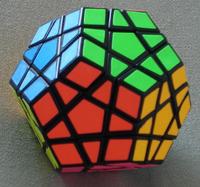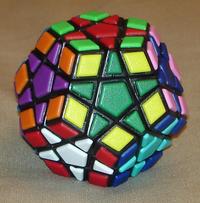| Revision as of 04:11, 24 May 2007 edit71.97.177.96 (talk) →Number of combinations← Previous edit | Revision as of 13:39, 25 May 2007 edit undoNetRolller 3D (talk | contribs)Extended confirmed users, Rollbackers1,853 editsm →Number of combinations: Remove multiplicaton by 1.Next edit → | ||
| Line 26: | Line 26: | ||
| == Number of combinations == | == Number of combinations == | ||
| The 12-color Megaminx has exactly 100,669,616,553,523,347,122,516,032,313,645,505,168,688,116,411,019,768,627,200,000,000,000 different positions, or approximately |
The 12-color Megaminx has exactly 100,669,616,553,523,347,122,516,032,313,645,505,168,688,116,411,019,768,627,200,000,000,000 different positions, or approximately 10<sup>68</sup>. | ||
| The 6-color Megaminx has 6,144,385,775,971,883,979,645,753,925,393,402,415,081,061,792,664,780,800,000,000,000, or approximately 6.1×10<sup>63</sup> positions. | The 6-color Megaminx has 6,144,385,775,971,883,979,645,753,925,393,402,415,081,061,792,664,780,800,000,000,000, or approximately 6.1×10<sup>63</sup> positions. | ||
Revision as of 13:39, 25 May 2007


The Megaminx is a dodecahedron-shaped puzzle similar to the Rubik's Cube. It has a total of 50 movable pieces to rearrange, compared to the 20 of the Rubik's cube.
History
The Megaminx, or Magic Dodecahedron, was invented by several people simultaneously and produced by several different manufacturers with slightly different designs. Uwe Mèffert eventually bought the rights to some of the patents and continues to sell it in his puzzle shop under the Megaminx moniker. It is also known by the name Hungarian Supernova. This was invented by Dr. Cristoph Bandelow . His version came out first, shortly followed by Meffert's Megaminx.
Description
The Megaminx is made in the shape of a dodecahedron, and has 12 face center pieces, 20 corner pieces, and 30 edge pieces. The face centers each have a single color, which identifies the color of that face in the solved state. The edge pieces have two colors, and the corner pieces have three colors. Each face contains a center piece, 5 corner pieces and 5 edge pieces. The corner and edge pieces are shared with adjacent faces. The face centers can only rotate in place, but the other pieces can be permuted by twisting the face layer around the face center.
There are two main versions of the Megaminx: the 6-color version in which opposite faces have the same color, and the 12-color version in which all faces have a different color.
The purpose of the puzzle is to scramble the colors, and then restore it to its original state of having one color per face.
Solutions
In spite of its daunting appearance and greater number of possible positions, the Megaminx is not much more difficult than the standard 3x3x3 Rubik's cube. This is because it is not a deep-cut puzzle; it only has pentagonal face layers which are similar in structure to the square face layers of the cube. There are no pieces that do not have a counterpart on the cube. Many of the techniques employed in the solution of the Rubik's cube can also be adapted for the Megaminx, except those that involve turning the center slice of the cube, since the Megaminx has no equivalent slice.
The 6-color Megaminx comes with an additional challenge which is not immediately obvious. Its edge pieces come in visually-identical pairs, because of the duplicated colors of opposite faces. However, although visually indistinguishable, they are nevertheless mathematically bound in a parity relationship. In any legal position (reachable from the solved state without disassembling the puzzle), there is always an even number of swapped pairs of edges. However, since swaps may be between visually indistinct edges, one may find that having solved almost the entire puzzle, one is left with a pair of swapped (distinct) edges that seems to defy all attempts to exchange them. The solution is to swap a single pair of 'identical' edges to reverse the parity, and then restore the rest of the puzzle.
This property is absent in the 12-color Megaminx, because all its edges are visually distinct, and it would be immediately obvious that there is another pair of swapped edges besides the pair one is working with.
Number of combinations
The 12-color Megaminx has exactly 100,669,616,553,523,347,122,516,032,313,645,505,168,688,116,411,019,768,627,200,000,000,000 different positions, or approximately 10. The 6-color Megaminx has 6,144,385,775,971,883,979,645,753,925,393,402,415,081,061,792,664,780,800,000,000,000, or approximately 6.1×10 positions.
See also
External links
- Meffert's puzzle shop
- Jaap's Megaminx page — contains solutions and other information
| Rubik's Cube | |||||||||||||||
|---|---|---|---|---|---|---|---|---|---|---|---|---|---|---|---|
| Puzzle inventors | |||||||||||||||
| Rubik's Cubes | |||||||||||||||
| Variations of the Rubik's Cube | |||||||||||||||
| Other cubic combination puzzles | |||||||||||||||
| Non-cubic combination puzzles |
| ||||||||||||||
| Virtual combination puzzles (>3D) | |||||||||||||||
| Derivatives | |||||||||||||||
| Renowned solvers |
| ||||||||||||||
| Solutions |
| ||||||||||||||
| Mathematics | |||||||||||||||
| Official organization | |||||||||||||||
| Related articles | |||||||||||||||